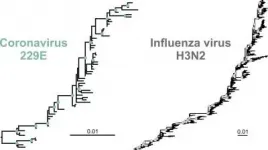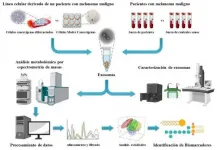Will COVID-19 vaccines need to be adapted regularly?
2021-03-25
(Press-News.org) Influenza vaccines need to be evaluated every year to ensure they remain effective against new influenza viruses. Will the same apply to COVID-19 vaccines? In order to gauge whether and to what extent this may be necessary, a team of researchers from Charité - Universitätsmedizin Berlin compared the evolution of endemic 'common cold' coronaviruses with that of influenza viruses. The researchers predict that, while the pandemic is ongoing, vaccines will need to undergo regular updates. A few years into the post-pandemic period, however, vaccines are likely to remain effective for longer. This study has been published in Virus Evolution*.
Influenza viruses are masters at evading the human immune system. They undergo such rapid changes that antibodies produced by the immune system in response to a previous infection or vaccination become unable to neutralize them. This is why the complex task of evaluating and updating the seasonal influenza vaccine has to be repeated every year. Mutations within SARS-CoV-2 have already produced a number of variants, some of which (such as the South African variant) partially evade the body's immune response. As a result, some vaccine manufacturers have already started to develop new versions of their vaccines. What does this mean for the future? Will COVID-19 vaccines mirror influenza vaccines in requiring regular updates?
In order to gauge whether, over the long term, SARS-CoV-2 is likely to demonstrate an immune evasion capability on par with that of influenza viruses, Charité virologists have studied the genetic evolution of the four currently known 'common cold' coronaviruses. These relatively harmless coronaviruses are known to be responsible for approximately 10 percent of common colds in the world and have been in circulation in humans significantly longer than SARS-CoV-2. Just like SARS-CoV-2, they enter human cells using the 'spike protein', a surface protein which gives the virus its characteristic crown-like appearance (and name). The spike protein also forms the target of all current COVID-19 vaccines.
For their study, the researchers focused on the two longest-known coronaviruses (termed 229E and OC43), tracing changes in the spike gene approximately 40 years into the past. The researchers started by comparing sequences from a range of old samples which had been deposited in a genetic sequence data bank. Based on the mutations which had emerged over time, they then produced phylogenetic trees for both coronaviruses. The researchers compared their findings with the phylogenetic tree of H3N2, an influenza subtype which is particularly effective at evading the human immune response.
The researchers' calculations revealed one feature which was common to the phylogenetic reconstructions of both the coronaviruses and the influenza virus: all three had a pronounced ladder-like shape. "An asymmetrical tree of this kind likely results from the repeated replacement of one circulating virus variant by another which carried a fitness advantage," explains the study's first author, Dr. Wendy K. Jó from Charité's Institute of Virology. "This is evidence of 'antigenic drift', a continuous process involving changes to surface structures which enable viruses to evade the human immune response. It means that these endemic coronaviruses also evade the immune system, just like the influenza virus. However, one also has to look at the speed with which this evolutionary adaptation happens."
For this step, the researchers determined the three viruses' evolutionary rates. While the influenza virus accumulated 25 mutations per 10,000 nucleotides (genetic building blocks) per year, the coronaviruses accumulated approximately 6 such mutations in the same timeframe. The rate of change of the endemic coronaviruses was therefore four times slower than that of the influenza virus. "As far as SARS-CoV-2 is concerned, this is good news," summarizes Prof. Dr. Christian Drosten, Director of the Institute of Virology and a researcher at the German Center for Infection Research (DZIF).
SARS-CoV-2 is currently estimated to change at a rate of approximately 10 mutations per 10,000 nucleotides per year, meaning the speed at which it evolves is substantially higher than that of the endemic coronaviruses. "This rapid genetic change in SARS-CoV-2 is reflected in the emergence of numerous virus variants across the globe," explains study lead Prof. Dr. Jan Felix Drexler, a researcher at both the Institute of Virology and the DZIF. "This, however, is likely due to the high rates of infection seen during the pandemic. When infection numbers are so high, a virus is able to evolve more rapidly. Based on the rates of evolution seen in the endemic common cold coronaviruses, we expect that SARS-CoV-2 will start to change more slowly once infections start to die down - meaning once a large proportion of the global population has developed immunity either as a result of infection or through vaccination. We expect therefore that COVID-19 vaccines will need to be monitored regularly throughout the pandemic and updated where necessary. Once the situation has stabilized, vaccines are likely to remain effective for longer."
*Jo WK et al. The evolutionary dynamics of endemic human coronaviruses. Vir Evol 2021. doi: 10.1093/ve/veab020
INFORMATION:
[Attachments] See images for this press release:

ELSE PRESS RELEASES FROM THIS DATE:
2021-03-25
Alzheimer's disease seems to progress faster in women than in men. The protein tau accumulates at a higher rate in women, according to research from Lund University in Sweden. The study was recently published in Brain.
Over 30 million people suffer from Alzheimer's disease worldwide, making it the most common form of dementia. Tau and beta-amyloid are two proteins known to aggregate and accumulate in the brain in patients with Alzheimer's.
The first protein to aggregate in Alzheimer's is beta-amyloid. Men and women are equally affected by the first disease stages, and the analysis did not show any differences in the accumulation of ...
2021-03-25
How different are men and women's brains? The question has been explored for decades, but a new study led by Rosalind Franklin University neuroscientist END ...
2021-03-25
GALVESTON, Texas - A new study conducted at the Galveston National Laboratory at the The University of Texas Medical Branch at Galveston (UTMB) has shown substantial benefit to combining monoclonal antibodies and the antiviral remdesivir against advanced Marburg virus. The study was published today in Nature Communications.
"Marburg is a highly virulent disease in the same family as the virus that causes Ebola. In Africa, patients often arrive to a physician very ill. It was important to test whether a combination of therapies would work better with really sick people, said Tom Geisbert, a professor in the Department of Microbiology & Immunology at UTMB and the principal investigator ...
2021-03-25
TROY, N.Y. -- Outsourcing routine tasks, like payroll, customer service, and accounting, offers well-known benefits to businesses and contributes to an economy in which entrepreneurial vendors can support industry and expand employment. However, new research from the Lally School of Management at Rensselaer Polytechnic Institute discovered that not all client-vendor relationships are beneficial for the vendors.
"It's important to observe and study both sides of a business relationship," said T. Ravichandran, a chaired professor of information systems in Lally and an author of a new study published in Information Systems Frontiers. "For businesses to thrive, they need a vibrant vendor community that will support ...
2021-03-25
The ocean's mammals are at a crucial crossroads - with some at risk of extinction and others showing signs of recovery, researchers say.
In a detailed review of the status of the world's 126 marine mammal species - which include whales, dolphins, seals, sea lions, manatees, dugongs, sea otters and polar bears - scientists found that accidental capture by fisheries (bycatch), climate change and pollution are among the key drivers of decline.
A quarter of these species are now classified as being at risk of extinction (vulnerable, endangered or critically endangered on the IUCN Red List), with the near-extinct vaquita porpoise and the critically endangered North Atlantic ...
2021-03-25
WASHINGTON -- Researchers have developed a new microscopy technique that can acquire 3D super-resolution images of subcellular structures from about 100 microns deep inside biological tissue, including the brain. By giving scientists a deeper view into the brain, the method could help reveal subtle changes that occur in neurons over time, during learning, or as result of disease.
The new approach is an extension of stimulated emission depletion (STED) microscopy, a breakthrough technique that achieves nanoscale resolution by overcoming the traditional diffraction limit of optical microscopes. Stefan Hell won the 2014 Nobel Prize in Chemistry for developing this super-resolution imaging technique.
In Optica, The ...
2021-03-25
Serotonin, or 5-hydroxytryptamine (5-HT), is a kind of neurotransmitter. 5-HT can regulate multifaceted physiological functions such as mood, cognition, learning, memory, and emotions through 5-HT receptors. 5-HT receptors are a type of G protein-coupled receptor and can be divided into 12 subtypes in humans. As drug targets, they play a vital role in the treatment of schizophrenia, depression, and migraine.
However, the structural and functional mechanisms of 5-HT receptors have been largely unknown.
In a study published in Nature on March 24, Prof. H. Eric XU and Prof. JIANG Yi from the Shanghai Institute of Materia Medica (SIMM) of the Chinese Academy of ...
2021-03-25
Their study has shown that these malignant melanoma vesicles produced by CSCs have a different molecular composition from that of differentiated tumour cells. These molecules were also found to be detectable in exosomes present in the blood, and they presented differences in patients with malignant melanoma compared to healthy individuals. This makes them potentially suitable as biomarkers for the diagnosis and prognosis of this disease.
The results have been published in the prestigious scientific journal Molecular Oncology.
Malignant melanoma is one of the most aggressive types of skin cancer and its prevalence has been increasing worldwide in recent years. Among the factors that contribute to the life-threatening nature and ...
2021-03-25
Dr. Rosario González-Férez, a researcher at the Department of Atomic, Molecular and Nuclear Physics and the "Carlos I" Institute of Theoretical and Computational Physics of the University of Granada, has published the article "Ultralong-Range Rydberg Bi-molecules" in the prestigious scientific journal Physical Review Letters. The results of the study show a new type of bi-molecule formed from two nitric oxide (NO) molecules, both in their ground state and in the Rydberg electronic state.
The work was made possible thanks to the scientific collaboration between the researcher and the Institute for Theoretical Atomic, Molecular ...
2021-03-25
The novel label-free assay uses unconventional L and inverse-L shaped pillars of deterministic lateral displacement (DLD) microfluidic technology to quantify and profile immune states of white blood cells (WBCs) by assessing biophysical properties of size, deformation, distribution, and cell count
The assay requires only 20 microlitres (μl) of unprocessed blood and takes just 15 minutes - much faster than existing methods which require up to 15 millilitres (ml) of blood and take at least a few hours to produce results
This new technology measures and profiles the often volatile host immune response, resulting in a more accurate assessment of patient pathophysiology
Current methods for early diagnosis of infection focus on ...
LAST 30 PRESS RELEASES:
[Press-News.org] Will COVID-19 vaccines need to be adapted regularly?




